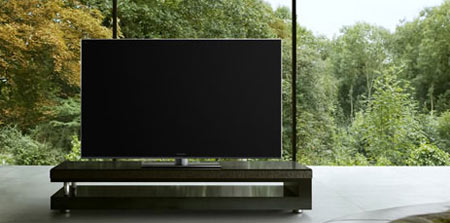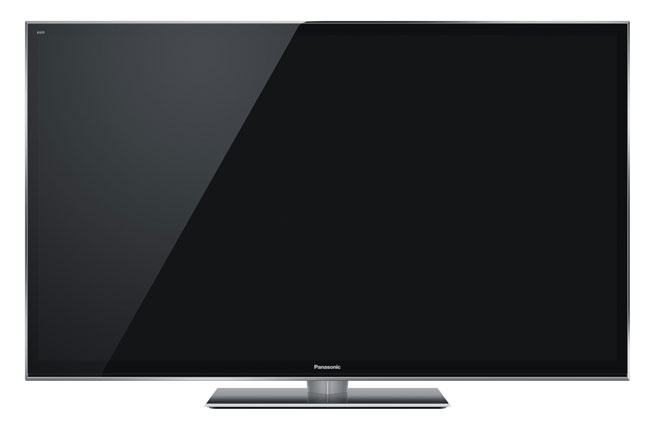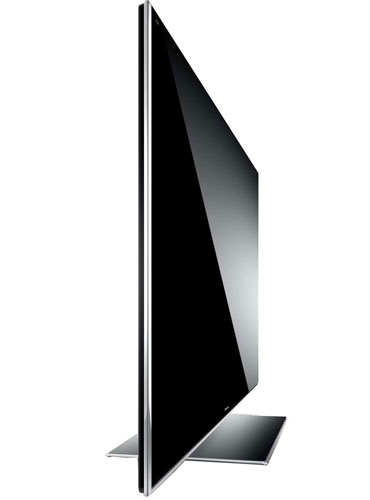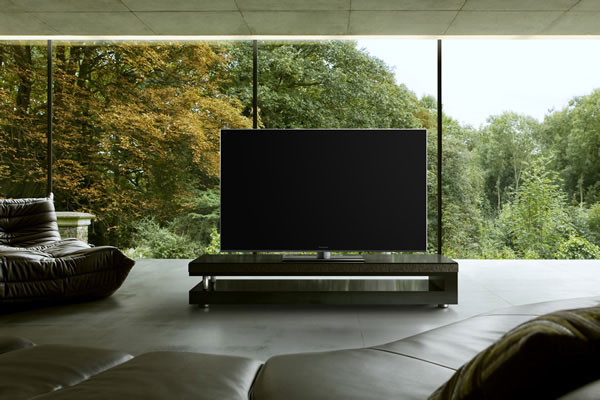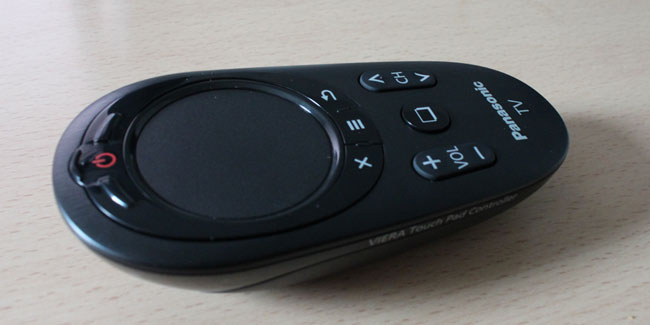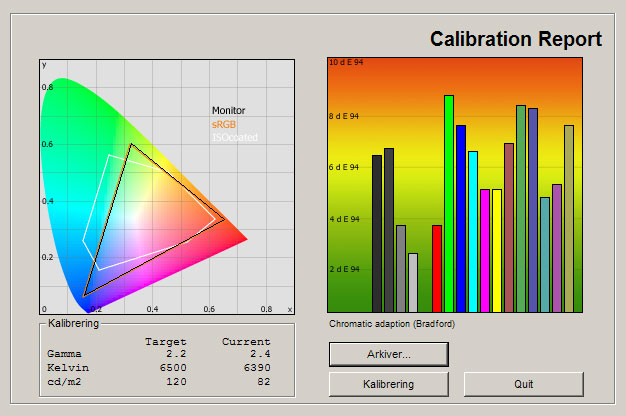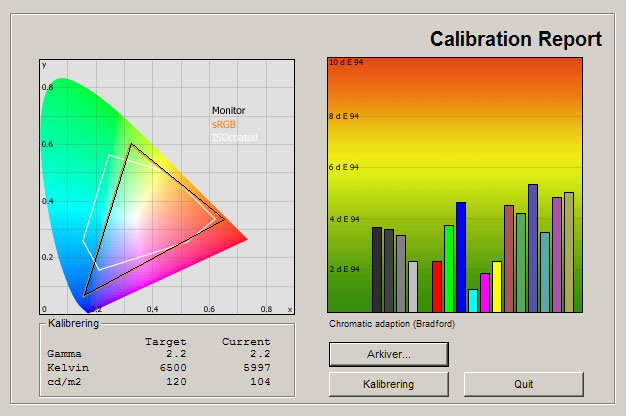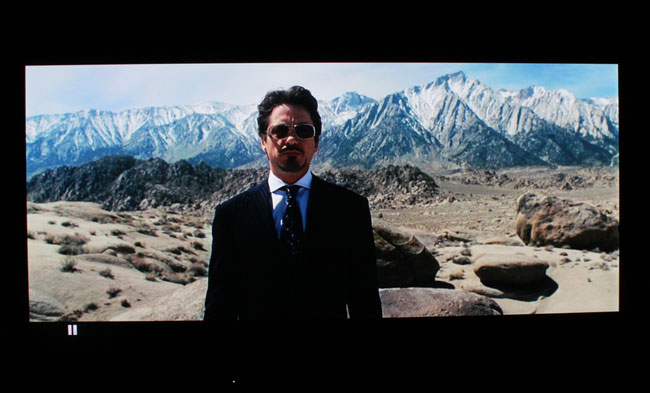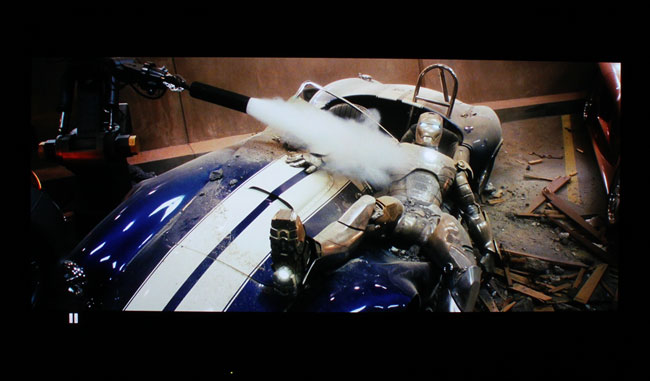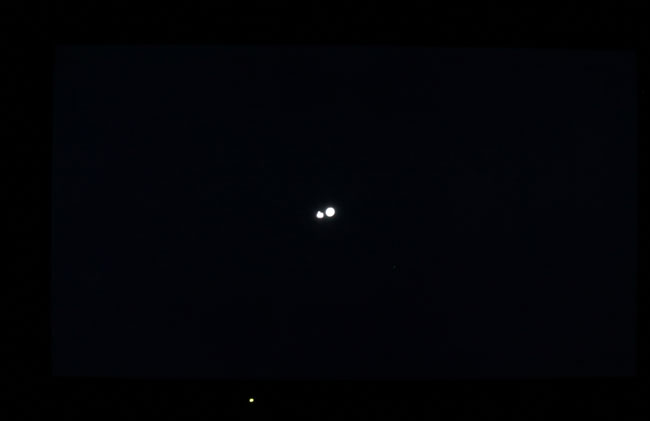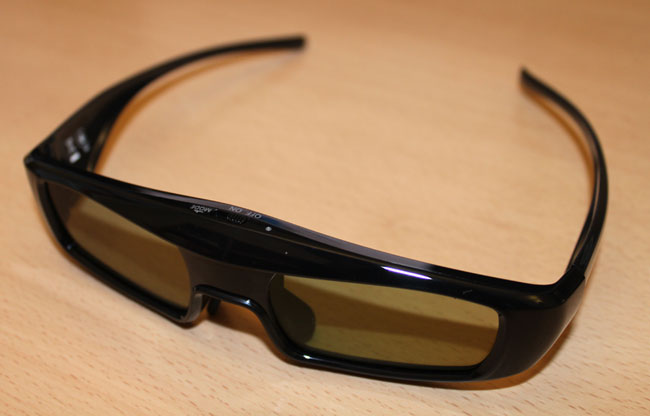Review: Panasonic VT50
TABLE OF CONTENTS Specs - Our first impressions - Test tools - Functionality - Power consumption - Calibration - Picture quality - 3D picture quality - PC & Media Center - Viewing angles - Sound - Conclusion - Debate Panasonic VT50 review
VT50 is Panasonic’s new plasma flagship TV. So what does a high-end TV in 2012 include? According to Panasonic, elegant design is important and VT50 looks more minimalistic than ever. VT50 also comes with Panasonic’s new anti-reflective louver filter and an improved plasma panel that goes by the name Infinite Black Ultra. In addition to this, Panasonic has included their complete Smart Viera platform with a dual-core processor and built-in WiFi.
Is VT50 a new reference TV? Can Panasonic take picture quality one step further? And is VT50 worth the extra price premium over the cheaper GT50 range? FlatpanelsHD will find out.
Panasonic VT50 will be available in 50 (EU only), 55 and 65 inches in Europe and the US.
Subscribe to our Newsletter, RSS feed or twitter to receive notice when new reviews are online.
Size: 50" widescreen Resolution: 1920x1080 Response time: - Contrast ratio: - Brightness: - Viewing angles (H/V): Angle Free Panel type: Plasma TV Wall mounting: Swivel stand: Dimensions (HxWxD): 70.6cm x 117.1cm x 5.0cm (without stand) Weight 25.5 kg Built-in speakers: Inputs VGA DVI (but possible to convert through HDMI)
Audio (type) (Audio in/out)
S-video Composite Component HDMI (4 inputs, 1 HDMI 1.4)
Outputs Audio (type) (1 output, headphones)
S/PDIF (optical)
Price and retailer:
| US retailer | UK retailer |
 |
Our first impressions
Panasonic VT50 is without doubt one of Panasonic’s most elegant plasma TVs to date. A few years ago, Panasonic lacked behind the competitors in terms of design but since the introduction of last year’s VT30 plasma TV, things have taken a new route.VT50 has a slimmer bezel than previous models and the TV is also very slim. There is a silver line around the TV and the front glass extends just a few millimeters out towards the viewer. It is a very nice detail.
Unfortunately, the base is made from plastic (metal inside, plastic layer outside) and it is identical to the one we saw on GT50. It has a built-in swivel function.
All input and output connectors – except the angled power plug – point either down or to the side.
From the front we heard no buzzing but when we moved closer and listened to the backside of the TV a quiet buzzing sound was heard. However, buzzing was louder on GT50, and the level of buzzing on our VT50 sample was not a problem during mixed use. We know from experience that buzzing can vary from model to model within the same TV range and we might have been lucky with our sample so please share your experiences in the debate thread.
Test tools
Our TV signal is DVB-S (satellite) from Canal Digital and DVB-T (terrestrial). We also have an analogue TV connection. Testing is done with the DVE (digital video essentials) and Peter Finzel test DVD. Testing is also done with DVD, TV, Blu-Ray and Media center/PC.We use our own monitorTest. The software supports some of the traditional test patterns used to evaluate displays as well as some new and unique test patterns developed by the people here on FlatpanelsHD.
Sony PlayStation 3 is our Blu-Ray player.
All contrast measurements are based on the ANSI methodology.
Functionality
We recently reviewed the Panasonic DT50 LED model and the GT50 plasma model. In these reviews we took a look at Panasonic’s many Smart TV features and the new app for smartphones and tablets. VT50 offers the same functions and I will therefore refer to the DT50 review for more information on the Smart Viera platform and to the GT50 review for more information about the dual-core performance and the iOS / Android app.The only difference between GT50 and VT50 is the touch pad remote, included with VT50. The touch pad remote is a supplement to the standard remote and offers a touch pad for easier navigation on web pages. It also has some additional buttons for channel switching, volume adjustment and a few other things.
The remote is not exactly pretty but it feels good in the hands. The small size fits naturally and every button is easy to reach with your thumb. The best thing; it is based on WiFi instead of infrared, so you can use it from everywhere. You do not have to point directly at the screen.
The touch pad area also functions as a button. Release your thumb and tap to make it work as an “OK” button. The touch pad itself is responsive and easy to operate. The Center button will take you straight to the Smart Viera home screen. All in all, a quite useful small remote that can help you with the everyday tasks – but also pretty useless if you own a smartphones.
Energy consumption
| Compare power consumption measurements on different TVs and monitors with our interactive power consumption applet here. |
 |  | |
| Standby | 0.3 W | 0.3 W |
| SD+HD | 173 W | 181 W |
| 3D | 232 W | 225 W |
After calibration we measured power consumption to 173 W, slightly higher than on Panasonic GT50 but not much, and on par with last year’s VT30 model.
Calibration on Panasonic VT50
Below you can see an out-of-box measurement on Panasonic VT50 in the Standard picture preset without Eco mode.| The graph says this: The number on the left is the delta value. Delta is a difference between two factors; here it’s the difference between the measured color on the panel and the actual color that is our target. |
Our measurements show that the out-of-box settings are wrong but also that the color deviations are more modest than the norm in the TV industry today. VT50 also gave us better results than the slightly cheaper GT50 TV, but color deviations are still too high.
The color deviations occur because gamma deviates from our 2.2 target. This is a common trick used to boost color intensity.
We changed to the THX Cinema profile and took a new measurement.
The THX Cinema profile is great. After a few years of testing Panasonic plasma TVs this was expected but they still deserve praise for their efforts. The THX preset is so close to the standards that it is often hard to talk about “calibration” on Panasonic’s TVs, since we are only able to achieve minor gains.
The THX mode gave us very low color deviations and very impressive accuracy. The color temperature is a nod too low but this is easily fixed and not enough to get destroy our enthusiasm.
Panasonic has also implemented a THX Bright Room profile that is characterized by a brighter picture, with some bright colors being oversaturated to compensate for a high level of ambient light in a typical living room. The THX Bright Room profile is a good addition and should be preferred for very bright living rooms. Brightness is still not impressive, though.
We moved on to calibrate Panasonic VT50. Here is the result.
We were able to improve color accuracy after calibration but the gains are modest. As said before, the THX profile is a great starting point and it makes a full calibration unnecessary for most users – unless you want the few extra percent and have access to calibration equipment.
Color deviations are now almost insignificant and the color temperature is spot on. Impressive.
Below are the calibrated settings.
 | |
| Viewing mode: | Professional1 |
| Contrast | 36 |
| Brightness | 0 |
| Colour: | 30 |
| Sharpness: | 2 |
| Vivid Color: | Off |
| Eco | Off |
| P-NR | Off |
| Gamma | 2.2 |
| Intelligent Frame Creation | Off |
| 16:9 Overscan | Off |
| 16:9 Overscan | Off |
| R-Gain | +1 |
| G-Gain | -3 |
| B-Gain | 4 |
| R-Cutoff | 0 |
| G-Cutoff | -2 |
| B-Cutoff | +1 |
Note: Some setting options are not active before you enable ISFccc in the Setup menu. The Eco option has been set to Off in the menu. Plasma TVs’ Eco functions work in a different manner than on LCD-TVs, and plasma TVs cannot reach the same brightness levels. Therefore the Eco sensor is not desirable.
Picture quality on Panasonic VT50
| In this section we go through picture quality with the calibrated settings. |
Panasonic boasts a new louver filter that should improve picture performance during daytime and reduce reflections from windows and lamps. The filter makes pictures on the TV noticeable darker when watched from above, in order to shield ceiling lighting. Most of the time, the filter seems to do what was intended but the problems with color washout remains in a very brightly lit room. And while VT50 is definitely better suited for a bright room that older plasma TVs due to the filter and a higher brightness level, I still believe that some users will experience issues placing the TV in very bright living rooms. We saw some improvement over Panasonic GT50, too.
Color accuracy on VT50 is excellent and color gradation is pretty convincing, too. Most colors are perfectly distinguished and only in the darker areas some minor issues occur. Like most other plasma TVs, the dark colors are made up from dithering and this shows. When viewed from a close distance some darks colors look “nervous” but from a normal viewing distance it is not visible. However, the dithering can sometimes cause mild color banding in fast moving scenes – like on all plasma TVs today.
SD picture quality has always been one of Panasonic’s plasma TVs strengths, and Panasonic VT50 is not an exception. SD pictures appear detailed and even during motion detailing is very high. Colors are accurate and daytime viewing is improved somewhat due to the Louver filter. VT50 still has a slightly too low brightness level for daytime viewing but the filter makes color washout less pronounced.
HD pictures are best described with one word: beautiful. Detailing is very high and we noticed how black depth is amazing, adding depth and intensity in pictures. We still experienced some minor color banding but only during motion. Dithering (which is visible when moving closer to the TV) is the cause but Panasonic has managed to reduce the color banding in the last few years, making it almost irrelevant during typical use. Motion reproduction is great too, which was expected. Compared to LCD panels – including Panasonic’s own – Panasonic’s plasma TVs maintains a higher level of detailing during fast motion in movies, sports and games. 1080p24 was also reproduced without issues.
VT50 is fast and by fast I mean one of the absolutely fastest TVs today. Blurring is at an absolute minimum and phosphor trailing is very, very modest. Phosphor trailing is still visible in for example black and white movies/games but besides that we never noticed the halos. Panasonic has improved VT50 a bit compared to last year’s line-up but even those TVs were pretty convincing in this regard.
Input lag was measured to 24-28 ms, which is very low compared to the typical LCD model but average for Panasonic’s plasma TVs. Input lag is close to impossible to detect during casual use and the low level of input lag, combined with the low level of motion blurring, makes Panasonic VT50 a great TV for console gaming. The experience is very smooth and without controller delay.
When Panasonic introduced their first 3D plasma-TV a few years ago and with it retention got worse. Since then Panasonic has managed to reduce retention again but VT50 is not retention-free. We never saw anything during casual use but after prolonged use, we did notice so retention. Nothing to worry about, and far less than on VT20.
Below we have measured black level and contrast.
 |  | |
| Black level | 0.00 cd/m2 | 0.00 cd/m2 |
| Brightness | 82 cd/m2 | 97 cd/m2 |
| Contrast ratio | - | - |
Contrast ratio +/- 50
After calibration measured black level to 0.0 cd/m2 but as discussed in the GT50 review, our testing equipment quits after 0.02 cd/m2. Therefore we examined VT50 in a completely dark room, and some light is being let through, making black appear very deep but not 100 % perfect. To be fair, this is one of the best results we have ever seen on a plasma TV, except for the Pioneer Kuro, and it contributes to vivid and intense pictures. Black depth on VT50 is not noticeable better than on GT50, though. In a dark room the two are fairly identical but VT50 has an advantage in a bright room due to the louver filter. With these results, Panasonic’s plasma TVs hold on to the lead over edge LED based LCD-TVs that have improved a lot in the recent years. This is very exiting; next step is perfection (all intermediate steps from here to perfect black are irrelevant).
Shadow detailing is great and only the darkest grey tone was hard to distinguish from black. But like most other Panasonic plasma TVs dark colors are created with the dithering method, meaning that some dithering noise occurs. From a distance it is impossible to see but if you sit close enough it is a bit distracting.
Below I have examined the Panasonic VT50 a completely dark room to see if it has clouding, backlight bleeding or floating black issues.
Panasonic VT50 has no issues with floating blacks.
3D picture quality on Panasonic VT50
| We used the PlayStation 3 and a 3D Blu-ray player to test 3D movies and 3D games. In this test I want to examine 3D depth, 3D picture quality, 3D crosstalk and finally include a small comparison to some of the other 3DTVs on the market. |
Panasonic’s new 3D glasses are seen below. They are lightweight but still not the most elegant solution around.
I feel that I am repeating myself here because what I saw on VT50 reminds me of GT50. 3D pictures look great and 3D depth is amazing. Crosstalk is reduced to an absolute minimum but is still visible in some high-contrast scenes. The 3D glasses still flicker during daytime and the 3D picture is also a bit too dark to really enjoy during daytime. But Panasonic’s plasma TVs are still the best 3DTVs to date if we look isolated at 3D picture quality.
But I also feel that VT50 and GT50 are extremely close when it comes to 3D picture quality. The two TVs exhibit similar characteristics and the differences are very small – if any. VT50 is targeted at home cinema enthusiast and gamers that want the best possible 3D picture quality – and it delivers that – but you can get pretty much the same from the cheaper GT50.
However, if you are planning on using 3D in a brightly lit living room, VT50 is not for you, and you should consider a passive 3DTV. There is still a range of limitations tied to the active shutter 3D glasses, including flicker during daytime, batteries (or constant charging), the cost, and the fragile nature of the two glasses (avoid stepping or sitting on the glasses because they will break).
PC and Media Center
In order to achieve 1:1 pixel mapping you need to select the aspect ratio called “16:9" in the TV settings. You also need to deactivate 16:9 Overscan.Viewing angles
Needless to say, viewing angles are very wide. No color washout occurs and even black depth is maintained from extreme angles. No need for pictures here.Sound quality
The speakers inside VT50 are decent and better than those found inside GT50. Sound is tighter, due to better bass and mid tones but the speakers are still too weak for movies and music in my opinion. Since VT50 is considered a high-end TV it will most likely be coupled with a separate sound system for movies so it the important thing here is naturally to decide if the speakers are good enough for casual viewing - which and they are.For movies, games and music I recommend separate speakers.
Conclusion
Panasonic VT50 is a Smart Viera TV with Panasonic’s entire suite of TV apps and media features, powered by a dual-core processor. It runs smoother than in 2011 but the platform still lacks content, quality TV apps and vision. The new media sharing features that allow you to stream content from a smartphone/tablet onto the TV screen are pretty good but limited by the fact that you have to do everything from within the smartphone/tablet app. With VT50, Panasonic has also aimed to create an elegant TV and they have largely succeeded. With its conservative style, slimmer bezels, and black materials, it fits nicely into most homes. And our sample had no buzzing issues worth mentioning. Great.Panasonic’s VT models have long been considered some of the best TVs around, and VT50 builds on that foundation. We have not witnessed any revolutions in the last few years but we still continue to see evolutionary improvements in picture quality. VT50 has deeper blacks than ever and Panasonic is inching closer to the infamous KURO black levels. Color accuracy is impressive and motion reproduction is great. Panasonic VT50 still has some very minor color banding problems during fast motion but nothing worrying. We also noticed very moderate phosphor trailing in black/white scenes but this is also close to insignificant. The movie experience is great, gaming performance is great (due to fast response time and low input lag), and sports ditto.
Is Panasonic VT50 the perfect TV? No, not at all. The Louver filter improve daytime viewing but the relatively low brightness level and the glass layers still cause some color washout to occur. VT50 also suffers from dithering when watched from a closer distance, and even though 3D pictures look good with almost no crosstalk, we are still not enthusiastic about the active 3D glasses. And then the inevitable question: What about competition and Panasonic’s cheaper plasma TV ranges? Actually that is interesting and compared to GT50, we have to say that performance is closer than we had expected. At times there was no difference. The Louver filter improves daytime viewing but for the most part VT50 feels like a natural extension of GT50 into higher size classes – and maybe that is what it is supposed to be?
Still, VT50 is a fantastic TV. For your very bright living room you may still consider LED models but for everything else, it simply does not get much better, in today’s market, than VT50 in terms of picture quality. The TV deserves praise and our Highly Recommended Award.

Press the award logo to learn more.
Price and retailer:
| US retailer | UK retailer |
 |
 |  |  |
| SD & HD picture quality | Daytime performance still not great | Living room |
| Black depth | Still some color banding | Home Cinema |
| Fast response time and low input lag | Color dithering | Gaming |
| Color accuracy | Smart Viera lacks content, vision | |
| 3D picture quality | Active 3D glasses costly, flicker | |
| New media sharing features promising | ||
| No audible buzzing on our sample |
Subscribe to our Newsletter to receive e-mails when new reviews are online.

